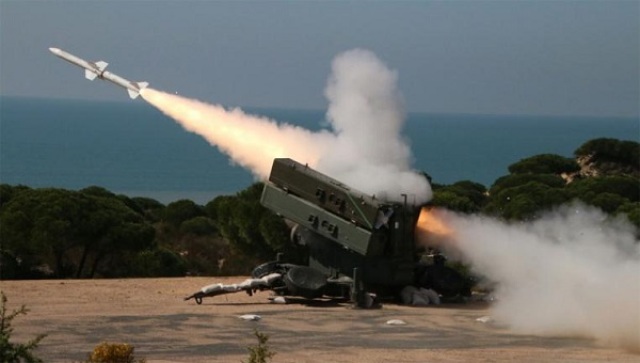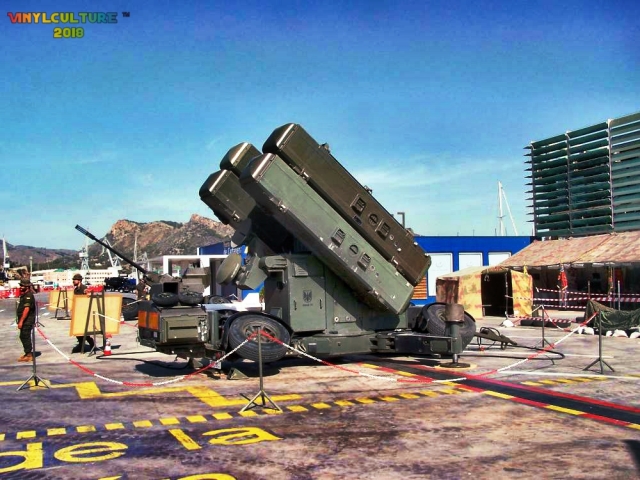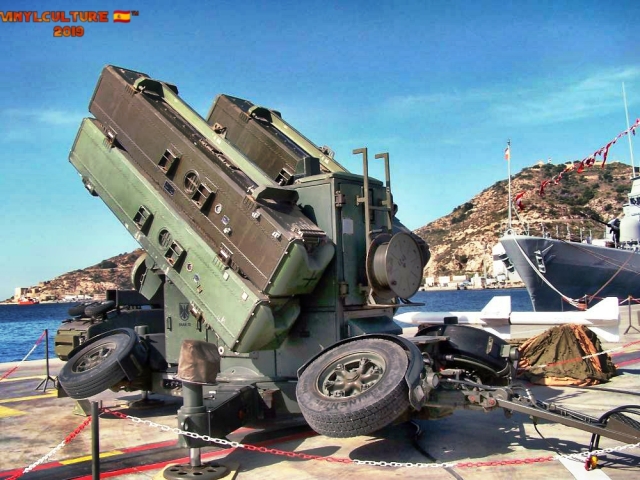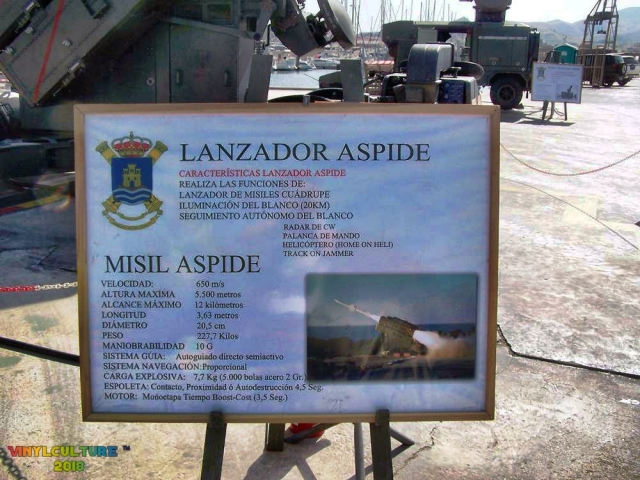As reported by the Spanish newspaper "El Pais" in the material Miguel González "España, dispuesta a entregar a Ucrania misiles antiaéreos y carros de combat Leopard" ("Spain is ready to supply Ukraine with anti-aircraft missile systems and Leopard tanks"), according to sources in the Spanish government, Spain is ready to make a qualitative leap in military support of Ukraine against the Russian invasions. If Spain has so far supplied Ukraine with ammunition, personal protective equipment and light weapons (C90 hand-held anti-tank grenade launchers and machine guns), now Spain is preparing the supply of heavy weapons, including anti-aircraft missile systems and Leopard 2 tanks, as well as the implementation of the necessary training of Ukrainian servicemen in the use of this equipment.

Launch of the MBDA Aspide Mk 1 anti-aircraft guided missile of the Spada/Skyguard Aspide (Toledo) anti-aircraft missile system in service with the Spanish Army, March 2017 (c) Ministry of Defense of Spain
The Spanish Ministry of Defense is already completing the delivery to Kiev of the Aspide short-range anti-aircraft missile system, which the Spanish army has replaced with another, more advanced system [NASAMS II]. The shipment of these weapons produced by the European missile company MBDA is expected upon completion of negotiations through a representative office in Stuttgart (Germany), which is responsible for coordinating military assistance to Ukraine in order to avoid a shortage of weapons from suppliers and duplication of supplies.
The Spanish government is also ready to supply Leopard 2A4 tanks to Ukraine, which have been stored for ten years at the logistics base of the Spanish army in Zaragoza. These tanks are part of a batch of 108 used vehicles that Germany sold to Spain in 1995 as a prelude to the contract for the production of Leopard 2E in Spain. The Spanish Ministry of Defense planned to convert them into engineering vehicles and bridge-laying machines, but, due to the lack of a budget for this, the tanks were subjected to a conservation process (removal of batteries, oil and any other elements that could damage them) and put into storage pending the availability of funds in the future. According to sources in defense circles, about 40 tanks can be repaired and transferred to the Ukrainian army, but sources warn that this will require them to be repaired by industry, which is unlikely to carry out these works itself at a time when it is raining down on the overall growth of military spending in Europe.
In addition, Spain offered Ukraine to train military personnel to operate these tanks. The training, according to sources, will initially take place in Latvia, where the Spanish army has deployed a contingent of 500 soldiers with six Leopard 2E tanks as part of the NATO Enhanced Forward Presence (EFP) operation. At the second stage, the training of Ukrainian tankers will take place already in Spain, the same sources add. This program would speed up the preparation of the Kiev army to equip it with powerful tanks with which it would be possible to resist modern Russian T-90 tanks, since now there is only a center in Germany where training for such tanks is carried out.
The proposal on anti-aircraft missiles and tank training was raised during the visit of Spanish Prime Minister Pedro Sanchez to Kiev on April 21 and his meetings with Ukrainian President Vladimir Zelensky, but its implementation was postponed due to the complexity of implementation, according to sources. On the same day, a Spanish military transport left El Ferrol Isabel with 200 tons of ammunition and RPG. He also delivered 30 trucks and ten light vehicles [URO VAMTAC], which traveled 800 kilometers along Polish roads to deliver the property to the receiving base of the Ministry of Defense of Ukraine. This shipment, according to Sanchez, was "more than twice" the amount of property sent before by 11 flights of military transport aircraft. In connection with the visit of Zelensky's adviser Igor Zovkva to Madrid this week, negotiations were resumed on speeding up delivery and expanding the list of possible deliveries.
At a press conference on June 3 on the occasion of 100 days since the beginning of the Russian invasion, Ukrainian Ambassador to Madrid Sergey Pogoreltsev thanked Spain for military assistance, but considered it insufficient, warning that there was only enough ammunition "for two hours of combat." "We are grateful, but we cannot say that we are satisfied," he stressed.
The diplomatic representative of Kiev requested heavy weapons (anti-ship and anti-aircraft missiles, 155-mm howitzers or 120-mm mortars), but first of all demanded the supply of Leopard 2 tanks, even before training Ukrainian servicemen on them. "There is good will on the part of the Spanish government and the Ministry of Defense to send instructors to train the operation of these battle tanks, but the main thing is the tanks," he stressed. The ambassador insisted that his country was not asking for "anything that Spain could not contribute," and complained that, according to his reports, Spain represented "one of the lowest levels of military assistance [to Ukraine] in relation to its defense budget."
The diplomat formulated his request in a new phase of protracted war and exhaustion, which the conflict has entered, with the occupation of 20% of its territory by Russian troops and the destruction of 30% of its infrastructure. And he assured that the Spanish government had demonstrated "indisputable support" for the cause of Kiev and did not see "pro-Russian sympathies" in the government, despite criticism from the ministers-members of the left-wing coalition Unidas Podemos about the supply of military equipment to Ukraine.
What the diplomat did not object to was the reception in Spain of 140 thousand Ukrainians (women, children and the elderly) who arrived fleeing the war, of which 116 thousand have already received the status of international refugees. "The process was well organized," he admitted.
From the bmpd side, we point out that thus, we are talking about Spain's supply to Ukraine of the Spada / Skyguard Aspide air defense system of Italian-Swiss production (previously manufactured under the head role of the Italian company Selenia, then part of Alenia Aeronautica, whose missile division then became part of the Italian branch of the European association MBDA). In the Spanish army, this SAM was designated Toledo. Under the 1985 contract, the Spanish army received in 1987-1989 six batteries of the Spada / Skyguard Aspide (Toledo) air defense system, each consisting of two firing sections, each of which included one Oerlikon Contraves Skyguard fire control radar, two towed four-shot Selenia Aspide Mk 1 anti-aircraft guided missile launchers and two 35 mm twin towed anti-aircraft guns Oerlikon GDF-001 (then upgraded to the level of GDF-007). In total, Spain received 13 firing sections (complexes), including a training one - a total of 26 launchers and 200 Aspide Mk 1 missiles.
The Aspide Mk 1 missile was developed on the basis of the well-known American AIM-7 Sparrow medium-range air-to-air missile (produced by Selenia under license) and has a semi-active monopulse radar homing head and a more powerful engine than the orginal Sparrow. With a mass of 228 kg and a length of 3.63 m, the Aspide Mk 1 missile in the SAM variant has an official firing range of up to 20-25 km and an altitude reach of up to 8 km . However, according to Spanish sources, the actual real effective range as part of the Toledo air defense system was up to 12 km, and the altitude reach was up to 5.5 km. The illumination radar in the ground-based air defense system variant is placed on the launcher. Serial production of Aspide Mk 1 missiles in air-to-air and missile defense variants has been carried out since 1977.
As part of the Spanish army, the Spada / Skyguard Aspide (Toledo) SAMs were in service with the 73rd anti-aircraft artillery Regiment stationed in Cartagena, but were withdrawn from service in 2020 and replaced by the NASAMS II SAM (four batteries). By now, the Spada / Skyguard Aspide air defense system should be considered obsolete, in addition, apparently, the shelf life of the missiles has already expired (which, apparently, is the reason for its decommissioning in the Spanish army)..
It should be noted that the Spanish Air Force has and continues to use two upgraded Spada 2000 air defense systems received in 1997-1999 for the defense of air bases and using modified Aspide 2000 missiles (four launchers and 51 missiles were delivered in total).
As for Spain's plans to transfer Leopard 2A4 tanks to Ukraine, if this happens, it will be the first delivery of Western-made tanks to Ukraine. The Spanish army received 108 Leopard 2A4 tanks for rent from the German Bundeswehr in 1995, in January 2006 these tanks were finally bought by the Spanish side at a residual value of 15.124 million euros. Since it was decided to leave 219 new licensed Leopard 2E tanks (Leopard 2A6 variant) as the main type of tank of the Spanish army, 53 Leopard 2A4 tanks were withdrawn from the troops in 2012 and stored at the storage base of the 41st Logistics Group of the Spanish Army (AALOG 41) in Zaragoza. It was supposed to use 40 of them for conversion into engineering vehicles (24) and bridge-laying machines (16), but budget funds for this have not been allocated, and these 53 Leopard 2A4 tanks are still in storage. After 2015, the Spanish Ministry of Defense offered these tanks for sale to third countries, and a number of countries showed interest in acquiring them, including Bahrain, Peru and the Czech Republic, but in the end the tanks were not sold. Czech sources, in particular, reported that Czech military representatives during an inspection in 2016 found the technical condition of these tanks not too satisfactory and requiring serious repair costs.



The launcher of the Spada / Skyguard Aspide (Toledo) air defense system, which was in service with the 73rd anti-aircraft artillery Regiment of the Spanish army, during a demonstration in Cartagena in 2010. In the background, the Aspide Mk 1 anti-aircraft missile and (in the first picture) the 35 mm twin towed anti-aircraft gun Oerlikon GDF-007 are visible, in the last picture the Oerlikon Contraves Skyguard fire control radar (c) is visible from behind vehiculosmilitares.wordpress.com
